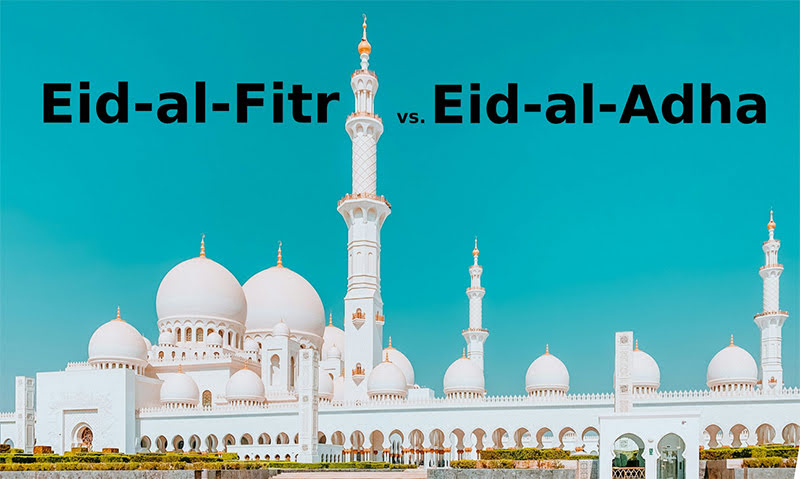Eid, meaning ‘festivity’ or ‘celebration’, is a renowned word in Islam. There are two dedicated times of Eid in Islam that Muslims praise as per the Prophet Muhammad’s (PBUH) heading: Eid ul-Fitr and Eid ul-Adha. These are times at which Allah (SWT) celebrates in His supporters being cheerful and energizes bliss among all.
Difference Between Eid-ul-Fitr and Eid-ul-Adha
Although Eid ul-Fitr and Eid ul-Adha are often confused, they are two distinct festivals with distinct meanings. Although they commemorate distinct events and, as a result, encompass two opposing aspects of Islam, the two festivals are observed in a manner that is comparable to one another.
What is Eid?
As previously stated, Eid is a time of joyful celebration. Eid ul-Fitr (also known as “small Eid”) and Eid ul-Adha (also known as “big Eid,” “Qurbani Eid,” “Bakra Eid,” or “Eid al-Kabir”) are the two types of Eid.
Read More:-
When is Eid?
The inquiry, “When is Eid?” Eid ul-Fitr is the next Eid after Ramadan, in case you were wondering. Despite being the lesser of the two Eids, this one is generally considered to be the more well-known of the two among non-Muslims.
When is Eid ul-Fitr?
Following Ramadan, the ninth month of the Islamic (lunar) calendar, is Eid ul-Fitr. As a result, Eid ul-Fitr is the first of the Eids because it occurs before Eid ul-Adha. The last ten days of Ramadan are said to bring blessings equivalent to a thousand months, and Eid celebrations are the ideal way to conclude the month of fasting and charitable giving.
When is Eid ul-Adha?
Qurbani, which falls during the 12th month of the lunar year, is one of Muslims’ holiest times of the year. Eid ul-Adha prayers must have been observed for Qurbani to begin. This places the date of Eid ul-Adha after Eid ul-Fitr, making it part of Dhul Hijjah. Since the Islamic calendar is based on the moon’s cycle, the exact dates for both Eids vary from year to year, with one or both Eids occurring approximately 10 or 11 days earlier each year.
Eid Greetings
To wish each other a favored Eid ul-Adha, “Eid Mubarak” is the nonexclusive hello. Additionally, it is used on Eid ul-Fitr. To be more specific, you could say “Eid ul-Fitr Mubarak” or “Eid ul-Adha Mubarak,” but because the two holidays are celebrated at different times of the year, “Eid Mubarak” is sufficient.
Read More:-
Universal Account Number (UAN) Login
What is Eid ul-Fitr?
Eid ul-Fitr is a one-day celebration that marks the end of Ramadan. It is a thanksgiving to Allah (SWT) for providing you with the strength to endure the Ramadan fast. Therefore, how is Eid ul-Fitr observed? The day consists of several parts, including:
- greeting the family and getting up early Salah (prayer) practice Ghusl is the act of ablution.
- Getting dressed for the day ahead and preparing one’s clothes, often brand-new clothes Plunking down for breakfast with loved ones
- Guaranteeing Zakat-ul-Fitr is paid before Eid Salah
- Performing Eid Salah in assemblage exchanging
- greetings with other Muslims and wishing them
- Happy Eid celebrating and visiting friends and family
Thank Allah (SWT) for giving those who were able to fast successfully the strength to get through the difficult month of Ramadan. If you are liable to pay Fidya or Kaffarah and broke the fast, you must ask Allah (SWT) for mercy and the strength to pay.
What is Eid ul-Adha?
Eid ul-Adha is a time to honor the devotion of the Prophet Ibrahim (AS), who obediently prepared to sacrifice his son Ismail for Allah (SWT) during this time. As a sign that the sacrifice had been a test, Allah (SWT) spared Ismail’s (AS) life by substituting him for a ram at the last moment. During Eid ul-Adha, this is celebrated through Qurbani, or animal sacrifice in the name of Allah (SWT). The Eid Salah is immediately followed by this sacrifice.
How Many Days is Eid ul-Adha?
Similar to Eid ul-Fitr, the Muslim community celebrates Eid ul-Adha for three days, which is a time of pure joy and celebration. It is a national holiday in nations with a large Muslim population.
Read More:-
What Links Eid ul-Adha & Eid ul-Fitr?
During Eid ul-Fitr, which marks the end of Ramadan, Zakat ul-Fitr is offered to those who are hungry. Qurbani, or the offering of an animal as a sacrifice, is a part of Eid ul-Adha. After that, the animal is broken up into three parts, one of which is given to people who are poor. Islam places a high value on charity. We are privileged to be able to celebrate it with our brothers and sisters all over the world because it is a significant expression of Allah’s (SWT) love for us.
Final Words
Eid-ul-Fitr and Eid-ul-Adha are the two major celebrations that mark the Islamic calendar’s most significant holiday, Eid. While the two celebrations are seen with gigantic happiness and intensity, they each convey particular implications, narratives, and ceremonies. Understanding the distinctions between Eid-ul-Fitr and Eid-ul-Adha reveals insight into the assorted embroidery of Islamic culture and custom.
